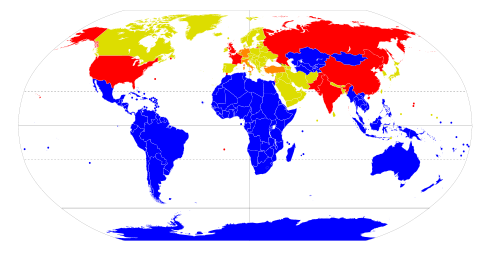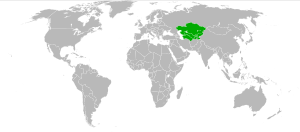
Central Asian Nuclear Weapon Free Zone
Encyclopedia
The Central Asia
n Nuclear-Weapon-Free Zone
(CANWFZ) treaty is a legally binding commitment by Kazakhstan
, Kyrgyzstan
, Tajikistan
, Turkmenistan
, and Uzbekistan
not to manufacture, acquire, test, or possess nuclear weapons. The treaty was signed on 8 September 2006 at Semipalatinsk Test Site
, Kazakhstan, and is also known as Treaty of Semipalatinsk, Treaty of Semei, or Treaty of Semey.
The treaty was ratified by Kyrgyzstan, Uzbekistan,, Turkmenistan Tajikistan and Kazakhstan,
and entered into force 2009-03-21.

in 1997 and reaffirmed in 2000.
Mindful of the lack of support by the nuclear powers for a similar Southeast Asian Nuclear-Weapon-Free Zone Treaty
, the five permanent members of the Security Council were involved in the negotiations.
While Russia
and China
approved of the treaty, United States
, France
and United Kingdom
objected to a clause which stated that the Treaty would not affect the rights and obligations of the signatories under previous international agreements because of the already existent Tashkent Treaty which involved Russia
.
The United States also objected on principle to establishment of any zone disturbing "existing security arrangements to the detriment of regional and international security or otherwise abridg[ing] the inherent right of individual or collective self-defense guaranteed in the UN charter".
The United States also objected to possibility that Iran
could apply to join the Treaty, so this provision was removed.
The United States
, United Kingdom
, and France
were finally concerned about the possibility that the Treaty could forbid the transit of nuclear weapons through the territory.
In spite of attempts by United States
, United Kingdom
, and France
to block the Treaty, it was finally signed in September 2006, although they voted against the General Assembly Resolution which welcomed the signing of the treaty in December 2006.

Central Asia
Central Asia is a core region of the Asian continent from the Caspian Sea in the west, China in the east, Afghanistan in the south, and Russia in the north...
n Nuclear-Weapon-Free Zone
Nuclear-Weapon-Free Zone
A nuclear-weapons-free zone, or NWFZ is defined by the United Nations as an agreement which a group of states has freely established by treaty or convention, that bans the use, development, or deployment of nuclear weapons in a given area, that has mechanisms of verification and control to enforce...
(CANWFZ) treaty is a legally binding commitment by Kazakhstan
Kazakhstan
Kazakhstan , officially the Republic of Kazakhstan, is a transcontinental country in Central Asia and Eastern Europe. Ranked as the ninth largest country in the world, it is also the world's largest landlocked country; its territory of is greater than Western Europe...
, Kyrgyzstan
Kyrgyzstan
Kyrgyzstan , officially the Kyrgyz Republic is one of the world's six independent Turkic states . Located in Central Asia, landlocked and mountainous, Kyrgyzstan is bordered by Kazakhstan to the north, Uzbekistan to the west, Tajikistan to the southwest and China to the east...
, Tajikistan
Tajikistan
Tajikistan , officially the Republic of Tajikistan , is a mountainous landlocked country in Central Asia. Afghanistan borders it to the south, Uzbekistan to the west, Kyrgyzstan to the north, and China to the east....
, Turkmenistan
Turkmenistan
Turkmenistan , formerly also known as Turkmenia is one of the Turkic states in Central Asia. Until 1991, it was a constituent republic of the Soviet Union, the Turkmen Soviet Socialist Republic . Turkmenistan is one of the six independent Turkic states...
, and Uzbekistan
Uzbekistan
Uzbekistan , officially the Republic of Uzbekistan is a doubly landlocked country in Central Asia and one of the six independent Turkic states. It shares borders with Kazakhstan to the west and to the north, Kyrgyzstan and Tajikistan to the east, and Afghanistan and Turkmenistan to the south....
not to manufacture, acquire, test, or possess nuclear weapons. The treaty was signed on 8 September 2006 at Semipalatinsk Test Site
Semipalatinsk Test Site
The Semipalatinsk Test Site was the primary testing venue for the Soviet Union's nuclear weapons. It is located on the steppe in northeast Kazakhstan , south of the valley of the Irtysh River...
, Kazakhstan, and is also known as Treaty of Semipalatinsk, Treaty of Semei, or Treaty of Semey.
The treaty was ratified by Kyrgyzstan, Uzbekistan,, Turkmenistan Tajikistan and Kazakhstan,
and entered into force 2009-03-21.

History
Steps towards the establishment of such a zone began with the Almaty Declarationhttp://www.nti.org/db/nisprofs/shared/canwfz/almatdec.htm in 1992. A resolution calling for the establishment of such a zone was adopted by consensus by the United Nations General AssemblyUnited Nations General Assembly
For two articles dealing with membership in the General Assembly, see:* General Assembly members* General Assembly observersThe United Nations General Assembly is one of the five principal organs of the United Nations and the only one in which all member nations have equal representation...
in 1997 and reaffirmed in 2000.
Mindful of the lack of support by the nuclear powers for a similar Southeast Asian Nuclear-Weapon-Free Zone Treaty
Southeast Asian Nuclear-Weapon-Free Zone Treaty
The Southeast Asian Nuclear-Weapon-Free Zone Treaty or the Bangkok Treaty of 1995, is a nuclear weapons moratorium treaty between 10 Southeast Asian member-states under the auspices of the ASEAN: Brunei Darussalam, Cambodia, Indonesia, Laos, Malaysia, Myanmar, Philippines, Singapore, Thailand, and...
, the five permanent members of the Security Council were involved in the negotiations.
While Russia
Russia
Russia or , officially known as both Russia and the Russian Federation , is a country in northern Eurasia. It is a federal semi-presidential republic, comprising 83 federal subjects...
and China
China
Chinese civilization may refer to:* China for more general discussion of the country.* Chinese culture* Greater China, the transnational community of ethnic Chinese.* History of China* Sinosphere, the area historically affected by Chinese culture...
approved of the treaty, United States
United States
The United States of America is a federal constitutional republic comprising fifty states and a federal district...
, France
France
The French Republic , The French Republic , The French Republic , (commonly known as France , is a unitary semi-presidential republic in Western Europe with several overseas territories and islands located on other continents and in the Indian, Pacific, and Atlantic oceans. Metropolitan France...
and United Kingdom
United Kingdom
The United Kingdom of Great Britain and Northern IrelandIn the United Kingdom and Dependencies, other languages have been officially recognised as legitimate autochthonous languages under the European Charter for Regional or Minority Languages...
objected to a clause which stated that the Treaty would not affect the rights and obligations of the signatories under previous international agreements because of the already existent Tashkent Treaty which involved Russia
Russia
Russia or , officially known as both Russia and the Russian Federation , is a country in northern Eurasia. It is a federal semi-presidential republic, comprising 83 federal subjects...
.
The United States also objected on principle to establishment of any zone disturbing "existing security arrangements to the detriment of regional and international security or otherwise abridg[ing] the inherent right of individual or collective self-defense guaranteed in the UN charter".
The United States also objected to possibility that Iran
Iran
Iran , officially the Islamic Republic of Iran , is a country in Southern and Western Asia. The name "Iran" has been in use natively since the Sassanian era and came into use internationally in 1935, before which the country was known to the Western world as Persia...
could apply to join the Treaty, so this provision was removed.
The United States
United States
The United States of America is a federal constitutional republic comprising fifty states and a federal district...
, United Kingdom
United Kingdom
The United Kingdom of Great Britain and Northern IrelandIn the United Kingdom and Dependencies, other languages have been officially recognised as legitimate autochthonous languages under the European Charter for Regional or Minority Languages...
, and France
France
The French Republic , The French Republic , The French Republic , (commonly known as France , is a unitary semi-presidential republic in Western Europe with several overseas territories and islands located on other continents and in the Indian, Pacific, and Atlantic oceans. Metropolitan France...
were finally concerned about the possibility that the Treaty could forbid the transit of nuclear weapons through the territory.
In spite of attempts by United States
United States
The United States of America is a federal constitutional republic comprising fifty states and a federal district...
, United Kingdom
United Kingdom
The United Kingdom of Great Britain and Northern IrelandIn the United Kingdom and Dependencies, other languages have been officially recognised as legitimate autochthonous languages under the European Charter for Regional or Minority Languages...
, and France
France
The French Republic , The French Republic , The French Republic , (commonly known as France , is a unitary semi-presidential republic in Western Europe with several overseas territories and islands located on other continents and in the Indian, Pacific, and Atlantic oceans. Metropolitan France...
to block the Treaty, it was finally signed in September 2006, although they voted against the General Assembly Resolution which welcomed the signing of the treaty in December 2006.
List of states

| State | Signed | Deposited |
 Kazakhstan Kazakhstan |
||
 Kyrgyzstan Kyrgyzstan |
||
 Tajikistan Tajikistan |
||
 Turkmenistan Turkmenistan |
||
 Uzbekistan Uzbekistan |
See also
- Nuclear-Weapon-Free ZoneNuclear-Weapon-Free ZoneA nuclear-weapons-free zone, or NWFZ is defined by the United Nations as an agreement which a group of states has freely established by treaty or convention, that bans the use, development, or deployment of nuclear weapons in a given area, that has mechanisms of verification and control to enforce...
- Lists of nuclear disasters and radioactive incidents

